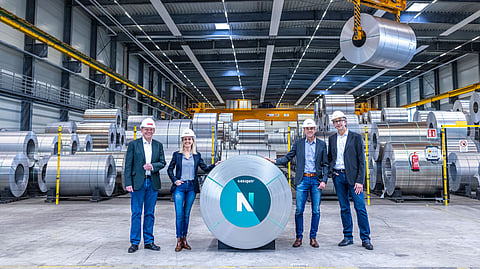
- Home
- EventsEvents
- Product Launches
- CategoriesCategories
- Advertise
- Opinion

GEA is to use its first consignment of “green stainless steel” in the production of its machinery and equipment. The stainless steel coil will be delivered to the GEA production site in Bönen (Germany) by Klöckner & Co’s German subsidiary Becker Stainless. In a pilot project, the material is being used to make the production of milking technology more sustainable, for example.
According to the “Product Carbon Footprint Declaration”, the carbon footprint of the stainless steel coil is around 90 percent less than that of conventional stainless steel. This puts it in the “Pro” category of Klöckner & Co’s proprietary Nexigen product categorization system for “green stainless steel”. In other words, the CO2 emissions from resource extraction and production to the point of delivery are fewer than 700 kg per ton of stainless steel (covering Scopes 1 to 3). With the delivery, GEA also receives the “Product Carbon Footprint Declaration”, which documents the precise kilogram value of the emissions generated from raw material extraction to production, processing and transport to the factory gate (cradle to customer entry gate).
By using “green stainless steel”, GEA is furthering the implementation of its Climate Transition Plan 2040 with the goal of achieving net-zero emissions. Cooperation with suppliers such as Klöckner & Co and leading stainless steel works in Europe is to be expanded over the coming years.
GEA’s chief sustainability officer, Dr. Nadine Sterley, said, “Our Climate Transition Plan 2040 sets clear targets for the reduction of our greenhouse gas emissions to net zero right across the value chain. As long as no other alternative to this material is available, green stainless steel is the best option for GEA. Starting now, we are adding it to our raw materials mix and will steadily increase the proportion it accounts for to reduce the emissions in our supply chain.”
“Our suppliers play a key role in achieving our climate targets,” says Johannes Giloth, member of the Executive Board and chief operating officer of GEA. “Sustainable procurement is crucial. That’s why we are working shoulder to shoulder with our partners to develop and offer resource-efficient solutions together. And we’re delighted to be successfully implementing this project with Klöckner & Co.”
Klöckner & Co chief executive officer Guido Kerkhoff, said, “Our primary aim with the Nexigen® umbrella brand is to help our customers make their supply chains greener. This makes it especially gratifying that our long-standing partner GEA has chosen Klöckner & Co to supply its first consignment of CO2-reduced stainless steel.”
Terms such as “green steel”, “green stainless steel” and “green aluminum” are on everyone’s lips. Yet despite the proliferation of labels and quality seals, there has long been no universal definition of when these products are “green”. That has made comparison difficult for customers. Klöckner & Co has come up with a CO2 categorization system based on customer demand, producer perspectives, production technologies, ISO standards and the GHG Protocol as the most widely used basis for greenhouse gas emissions accounting.
Under the Nexigen brand, Klöckner & Co provides full transparency regarding the product carbon footprint (PCF) from raw material extraction through production all the way to logistics (cradle to gate). Using the Nexigen PCF Algorithm, whose calculation method has been certified by TÜV SÜD, customers can retrieve the individualized PCF for almost any of Klöckner & Co’s approximately 200,000 products. The Nexigen Data Services technology solution not only enables customers to track product emissions, it also suggests greener alternatives and points to potential for reducing CO2 emissions.
Click HERE to subscribe to our FREE Weekly Newsletter
